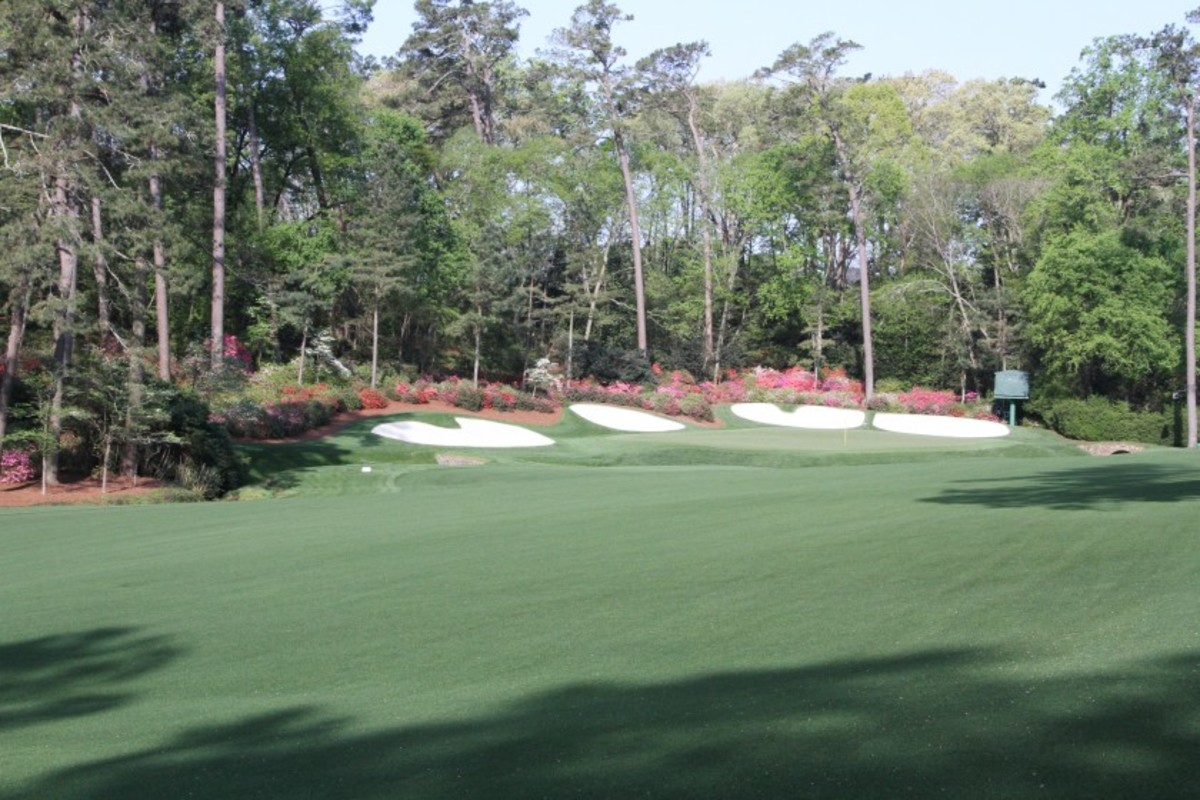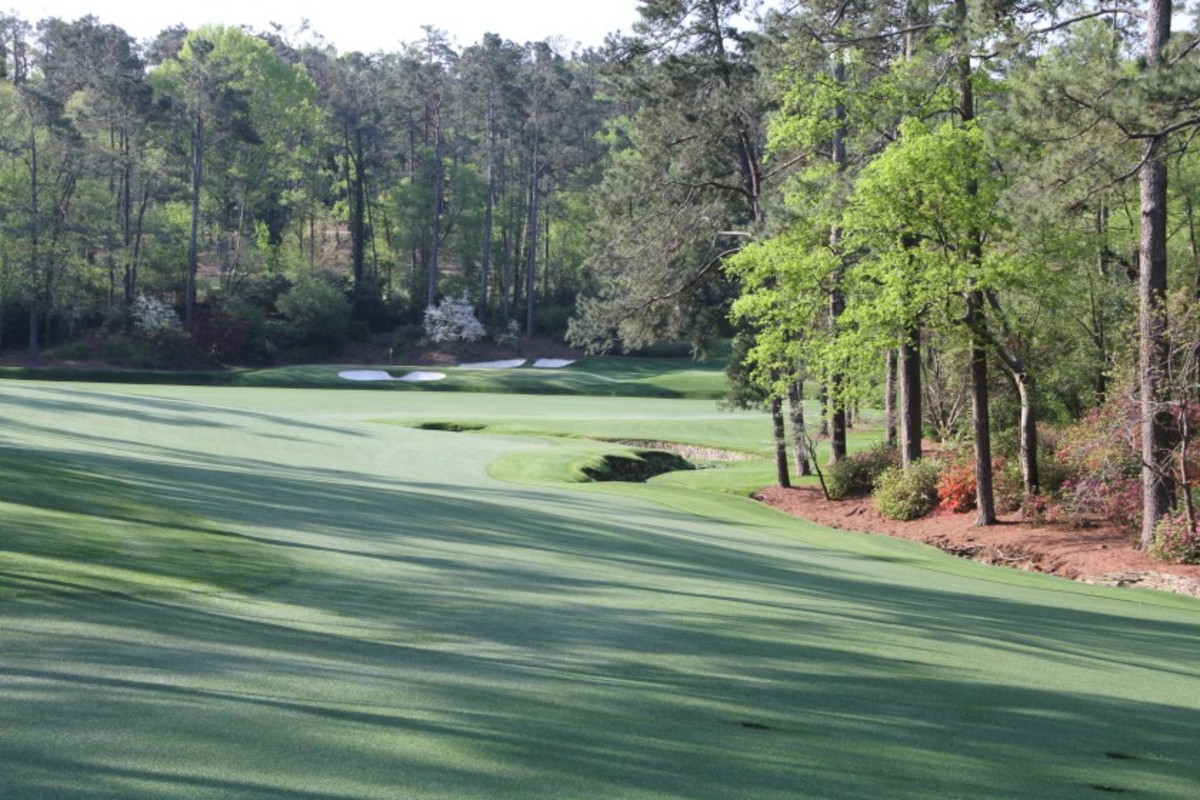Illuminating the Masters' 13th hole

Come mid-November, arguably the greatest inland hole in golf will again be on display, when Masters competitors confront Augusta National Golf Club’s par-5 13th. A nagging question persists, however. Is the 13th really great any longer, when it’s such a pushover? The short answer is yes, but with an asterisk.
Perhaps the world’s most beautiful parkland hole, Augusta National’s 13th has long been one of the most strategic as well, illustrating perfectly co-designer Bobby Jones’ fondness for what he liked to call a “par four and a half” hole. The hole is easily reachable in two shots by most low-handicap golfers — that is, if distance alone were the sole factor.
What vexes, though, is a tee shot that must curve hard from right-to-left to avoid running through the fairway into the pine trees. Players who find the fairway face a second shot from a tight, sidehill lie, over a twisting arm of Rae’s Creek, to a wildly contoured green. A drive pulled to the left will find the creek, or else run into any of the thousands of azaleas that color the hole in April — and could possibly be in bloom in November, as well. The four eye-candy bunkers beyond the green seldom come into play, but they frame the hole wonderfully.
At issue these days is whether the hole is even relevant any longer as a risk/reward par 5. Jones explained what he intended for the hole in his 1960 book, “Golf is My Game.”
“In my opinion this thirteenth hole is one of the finest holes for competitive play I have ever seen,” Jones wrote. “The player is first tempted to dare the creek on his tee shot by playing in close to the corner, because if he attains his position he has not only shortened the hole, but obtained a more level lie for his second shot. Driving out to the right not only increases the length of the second, but encounters an annoying sidehill lie.
“Whatever position may be reached with the tee shot, the second shot as well entails a momentous decision whether or not to try for the green …”
Alas, it’s hardly a “momentous” decision any longer. When most players in the field are wielding 6-, 7- or 8-irons for their second shot, it eliminates the uncertainty of whether or not a player should go for the green.

The powers that be at Augusta National have taken continual steps to keep shot values relevant over the years. They’ve lengthened holes, enlarged and relocated bunkers, altered mowing patterns and narrowed fairways by adding trees and a first cut of rough. Tweaks to the 13th include the addition of more pines on the outside elbow of the dogleg, a 3-foot-deep swale between the back bunkers and the putting surface — created by Jack Nicklaus in 1983 — and establishment of a new back tee in 2002 that stretched the hole from a petite 465 yards to a slightly more imposing 510 yards. In only a few short years, that new championship tee was rendered practically obsolete.
In 2017, the Golden Bear weighed in on the limitations of today’s 13th hole.
“In my prime, the 13th was not only one of my favorite holes, but was also one of the best in golf,” Nicklaus said. “It presented its risks and rewards perfectly. But the golf ball has changed things. If you’re not going to roll back the golf ball, you really need to lengthen the hole by 30 to 40 yards to test the players today.”
Clearly, the Masters poohbahs understand the problem. In August 2017, Augusta National purchased adjoining property behind the 13th tee that belonged to Augusta Country Club. Now, the hole can indeed be lengthened between 30 and 60 yards. Yet, three years later, the 13th hole still measures 510 yards. How to restore the shot values envisioned by course co-designers Bobby Jones and Alister MacKenzie might not be so clear-cut.
Augusta National chairman Fred Ridley addressed the 13th hole dilemma at his 2019 State of the Masters address. “Admittedly, that hole does not play as it was intended to play by Jones and MacKenzie,” he said. “The momentous decision that I’ve spoken about and that Bobby Jones often spoke about, of going for the green in two, is to a large extent, no longer relevant.”
Rather than carve out a new Masters tee at 13, however, Ridley and his cohorts have opted for a wait-and-see approach.
“While there’s no hesitation on my part or historically on the part of Augusta National to make changes that are necessary. … Amen Corner is a sacred place in the world of golf. I am hesitant to move too quickly in that regard,” Ridley said. “My preference would be to see what happens, what the governing bodies decide is best for the game, and then we will take appropriate action in response to that.”

Ridley and the Masters brain trust have chosen not to punt on what to do at the 13th hole, but rather to call time out. Ridley's 2019 comments about “what the governing bodies decide” alluded to the forthcoming Distance Insights Project, a collaborative effort from the USGA and R&A that was due to be published on February 4, 2020. Released on the scheduled day, the report’s 16-page conclusions stated, in part, “We believe that golf will best thrive over the next decades and beyond if this continuing cycle of ever-increasing hitting distances and golf course lengths is brought to an end.”
The ruling bodies intended to publish “a more specific set of research topics” within 45 days, together with input and feedback throughout the next year. Then the COVID-19 stop sign went up. Six months later, in August 2020, the USGA and R&A announced that they were now shooting for March 2021 for a fresh update to its Distance Insights Project report. Ridley and Augusta National had bought themselves more time to act on 13.
Even with all that land next door now available, it’s far from automatic that extra distance is the solution to cure No. 13. Earlier in 2020, nearly three dozen players shared their views with Golfweek, including 21 major winners and 11 Masters champs. Twenty-four players favored keeping the hole at the same length.
Many players suggested moving the tee box to the left, to make it more challenging to take it over the left-side trees. It would also force a more precise right-to-left curve to maneuver the drive around the trees. Others suggested planting one or more trees on the left side, close to the current tee box, to thwart the over-the-top shortcut. Rory McIlroy offered that merely lowering the present tee box by five feet would prevent the over-the-treetops route.
Yet, there’s three-time Masters winner Phil Mickelson, summing up for many others in saying, “(Move it back), because there’s too little risk when you’re hitting an 8- or 9-iron in.”
One final possibility? Leave everything as is, and convert the 13th hole to a par 4. “Sacrilege!” the purists would scoff. “How dare they destroy the character and tradition associated with one of earth’s most iconic holes.” OK, but remember that the even more iconic Road Hole, the par-4 17th at St. Andrews’ Old Course, played as a par 5 until 1964.
A recent, early October Eureka Earth image showed that there will not be a new back tee at 13 for the 2020 Masters. Clearing has been accomplished, a service road added and enhanced landscaping is in place, but no new tee box exists.
Sign up to receive the Morning Read newsletter, along with Where To Golf Next and The Equipment Insider.
